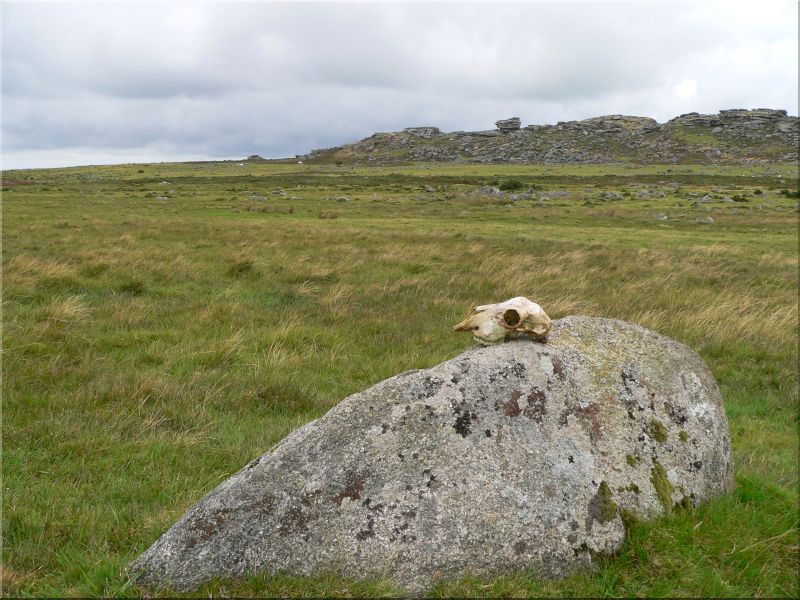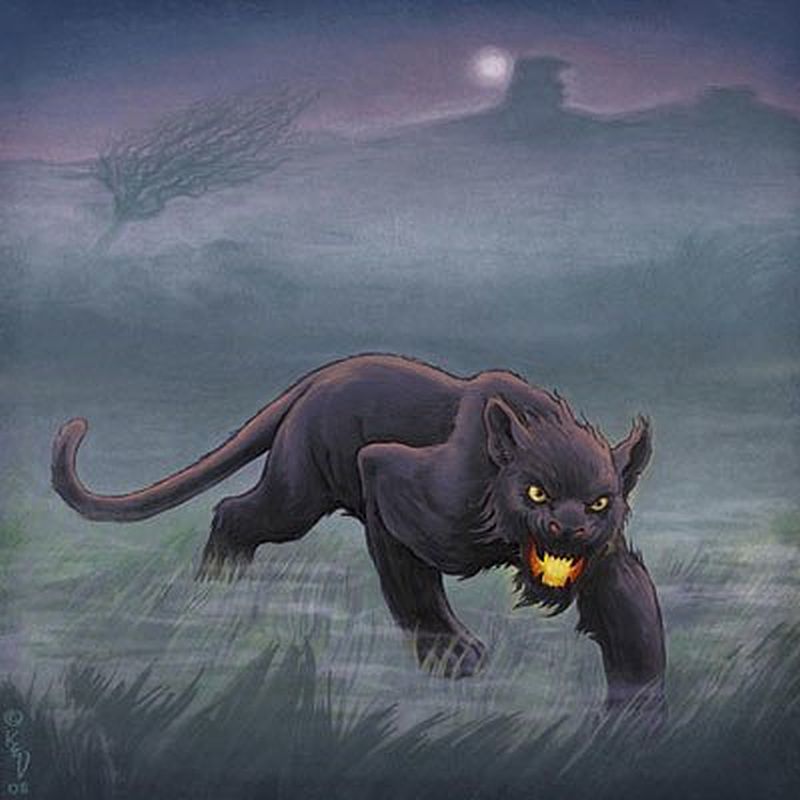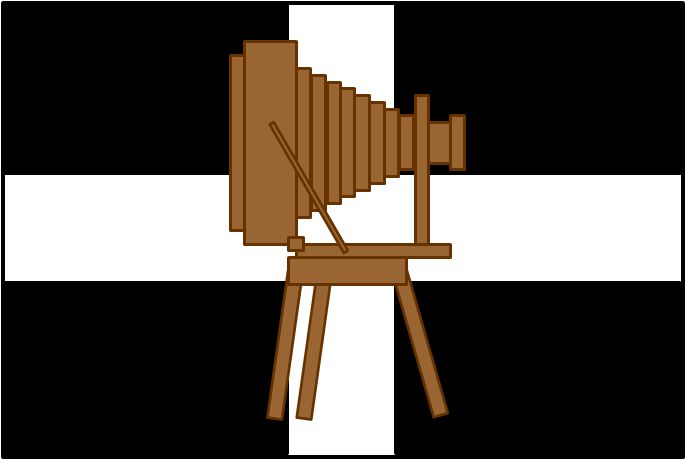(including photographs taken 2011)
Strange things happen on the moor. Sightings of "The Beast" have not gone away. In 2010 I had a report from someone who lived up on the north of Bodmin Moor, whose nephew...
"had been driving up the A39, and he and his wife had seen a big cat, crossing the road from our land. He described it as puma or lynx like... we have lost a lot of ducks on our lake over the last two months, higher loss rate than previously. I am definitely shutting all my animals in earlier, before it gets too dark."
So they are still around and there have been other sightings to the south of the Moor as well, together with sounds of them calling - a long “big meow-ing” kind of howl. Is the truth out there?

Not evidence, just a skull found out on the moor near Kilmar Tor.
But how did the sheep meet its end?
The March 2009 issue of Country Walking (a reputable magazine I believe!) ran “Big Cats run free in Britain”...
“Thermal imaging cameras set up by the Forestry Commission revealed two “unmistakable” sightings of big cats. The Government Agency was conducting a deer survey in the Forest of Dean when the large animals were spotted. These sightings have been confirmed by experienced rangers, and local police believe there are pairs of panthers living in the area. The Gloucestershire force gets reports of around 100 sightings a year.”
These sightings apparently took place in 2002 and 2005, but the details had only recently been released (January 2009), by the Forestry Commission under the Freedom of Information Act. They didn’t seem to want to show the film though!
So maybe I wasn’t just seeing things myself, back in 2008, when I saw a large dark feline shape run across the road at night, just ahead of the car headlights, near Wenmouth Cross on the southern edge of the moor (near St.Neot). Very feline, large, and with a long sloping tail. There have not been so many recent sightings either reported or given publicity over the past few years, but maybe these animals are just a little more accepted now? Do I believe they are out there myself? Well, when you see things, and hear things locally, and speak to honest people who live on and around the moor, yes, I do.
Reports have also reached me from over by Cardinham, that a mysteriously large cat was seen just across a nearby cattle grid one evening. Another report from a couple in Cardinham stated that at one time a couple of years ago, when they were walking their dog up on the Moor, that all of a sudden their dog (a large very happy rabbit hunter!) came rushing back and stuck by their leg all the way home - he was obviously very wary of something.
On another occasion, the same couple also saw something rushing through the gorse about 150 feet ahead of them - they only had a fleeting glimpse, but it wasn't a fox or a dog or a deer. Another person has also told of one evening when he was going down to close the gate at midnight, up on the moor near Colliford Lake - at a time when usually there were rabbits all over the place - that on that particular evening there was not a single one to be seen. Then a fox came out of the trees and walked right next to him all the way down the drive! Scared of something? Very unusual!
The Fowey valley running up on to the moor from Redgate and Golitha Falls to Bolventor has been a hot-bed of sightings in the past, and there was an article in the Independent from 1995 that had an interview with a farmer up the valley at Goodaver Farm. Asked about the "Beast", he replied "You'll know when the Beast's there. There'll be no rabbits or foxes about, and the birds stop singing. That's the call for caution."... "And the way they kill. If it's a dog there's wool and trouble everywhere. A cat goes in, kills and eats. Very little mess". The authorities will deny it all of course - that is their job is it not? There is no evidence, no proof, all of it is supposition, mis-identification, and can be explained by other animals. Such a possibility of "big cats" on the loose is just not what happens is it? It is not normal or accepted. Therefore it isn't a possibility. But there are many witnesses who have seen what they saw - and are not witnesses accepted as evidence in court? But no cats have been caught have they? So therefore they are not there.
Well, actually, one has. Back in 1980 a Puma was captured in Scotland in Inverness-shire, following several years of big cat sightings in the area. The Puma was believed to have been an abandoned pet, and it ended its days in the Highland Wildlife Park Zoo, and when it died, it was stuffed for posterity. "Felicity, the Cannich Puma" now resides in the Inverness Museum. For more sources and details, just search the internet. So there we have it. One has been caught.
There have been many false identifications of course, and many hoaxes. Perhaps one of the more well known and publicised - to de-bunk the big cat theorists - was the case of the skull that was found at Golitha Falls on 24th July 1995. A boy discovered a large cat skull in the water, which was large, about seven inches long, missing its lower jaw, but it had two sharp and prominent incisors, suggestive of a large cat. The skull was sent to the Natural History Museum for investigation, but although it was found to be the skull of a young male leopard, it was also found not to have died in this country, but imported as part of a leopard skin rug! A good try on the part of the hoaxers I suppose, but not much help!
With the advent of YouTube, there are now more and more video clips being made available on social networks, and perhaps one of the best examples of late, for the evidence of the existence of big cats, is this one...
The YouTube "Big Cat" Videos
This particular video is described as possibly "one of the best pieces of footage of a big cat in the UK" after a military policeman caught pictures of the animal on his phone walking along the side of railway tracks in Scotland. If you follow the video link above, you will find many more video examples, as long as you sort the plausible from the ludicrous!
So what are these mysterious Big Cats?
Where do they come
from?
Well, the most likely species of big cat that have been seen, and could now be breeding on and around Bodmin Moor - our famous or notorious "Beast", the Beast of Bodmin Moor - are likely to be either a Black Leopard (or Panther), or a Puma. These two species are often confused with one another. The Panther is a large long-tailed black cat, and the Puma is a large long-tailed brown cat (Black Pumas are extremely rare, only recorded wild in South America, and none in Europe).
The Lynx in comparison, is a medium-size short-tailed brown cat, and is easily identified by long hairs on top of its ears, making it quite distinctive. Most sightings of Big Cats, which is certainly true on and around Bodmin Moor, are of large long-tailed black or brown cats - in other words, Panthers or Pumas.
But where do they come from? They are certainly not an indigenous species, and they do not appear by magic. So that would suggest only one thing. They have been put there. There is also a very rational and acceptable explanation for exactly how they got there, even if it would seem very unlikely to happen today. Back in the 1970s however, times were perhaps a little different, a little more carefree, and maybe just a little more irresponsible in comparison with today. In 1976, the Dangerous and Wild Animals Act came into force, and together with a number of private owners of such animals perhaps feeling the pinch of the cost of looking after them at the time, and indeed before this time, the Act created a new situation of much tighter control of the ownership of such animals. When these new regulations were brought in, requiring greater governmental control and animal/owner registration - and cost - to owners of wild animals that were kept in zoos and small animal parks and the like, they created a situation where some people took the - much cheaper - short cut, and simply released them. Now that couldn't be done with some animals of course, but cats? And somewhere like Bodmin Moor? The perfect place to release them without suspicion, where they had the best chance of survival, and where there was a good source of wild food. Urban (or rural!) myth? Perhaps. But tales get told, and some things happen.
I have heard tales told from people around at the time, who supposedly knew what went on, of when places like the old zoo at Gunnislake ("Lorna's Mini Zoo) closed its doors in 1970. An article appeared in the press at the time that a grant of planning permission was recommended for three years, on condition that it got rid of its two bears and two Pumas. This is just an example of course, and there is no evidence to substantiate such suppositions, but this is where these kind of tales come from. Not far from Bodmin Moor is it? Were they just tall tales improved a little in the telling, just to impress? Or were they based on fact? Where did the Pumas and the Panthers from these old, now closed zoos or private collections (some of which have been described as "chicken wire jobs")* go to? Were they destroyed? Or sold? Or did they just mysteriously "disappear"? It's all now somewhat lost in the mists of time 45 years later, and any evidence of such deeds would certainly have been lost in the mists out on the moor. Perhaps the truth really is out there!
* Back in 2004 there was an excellent debate that took place at the (then) Plymouth College of Further Education, chaired by Tony Barber, and including Chris Moiser, a biology lecturer at the time, with a keen interest in African animals, including crocodiles, zebras and exotic cats. The transcript of this debate, titled "Alien Big Cats", including this reference, is very informative and was at one time available on the internet, but sadly I have found no current links to it. Some information here on old zoos and possible cat releases is derived from this debate.

This is an excellent artistic rendition of the fabled (if rather
fearsome!) "Beast of Bodmin Moor" by Kevin Levell
(© Image is
copyright of Kevin Levell)
You can see more imaginative and
skilful comic illustrative art on the new Kevin Levell website and
Gallery, and
Blog.
There are also many books out there on the subject of Big Cats, but the one from Bossiney Books (also by Chris Moiser) is a very handy and inexpensive one, and very considered in its views... try Mystery Cats of Devon and Cornwall. Certainly available in "all good bookshops" down here in Cornwall!
A Little Light-hearted Take on the Matter
Just in case you maybe choosing to take a walk on the moor today...
 If
you go up on the moors today
If
you go up on the moors today
You're sure of a big surprise.
If
you go out on the moors today,
You'd better go in disguise.
For ev'ry Beast that ever there was,
Will gather there for
certain, because
Today's the day the pussy cats have their
picnic!
For ev'ry Beast who's never been good,
Is sure to turn up in
case
There's lots of juicy bunnies to eat,
And lovely lambs
and children to chase.
Beneath the trees,
Beside the hedge,
They'll prowl and
hunt as long as they please.
And that's the way the Beasts are
having their picnic.
Picnic time for pussy cats!
The pussy cats are out and about
and having a play.
Watch out! They’ll catch you out!
And have
you for their tea today.
See them sneak and creep about,
They love to seek you out,
And make you squeal and shout!
At six o' clock,
Their tummies are rumbling,
And they’ll
take you home for tea!
'Cause they're hungry little pussy cats.
If you go up on the moors today,
You'd better not go alone.
It's lovely out on the moors today,
But safer to stay at home.
For ev'ry Beast that ever there was,
Will gather on Bodmin
Moor for certain, because
Today's the day the Beasts are having
their picnic.
With apologies to the original Teddy Bear lyrics of Jimmy Kennedy (1932), and to the original musical rendition by Henry Hall (1932).


Connect with us, Like us and Follow us on Facebook!
PhotoFile Cornwall supports CoaST and Sustainable Tourism